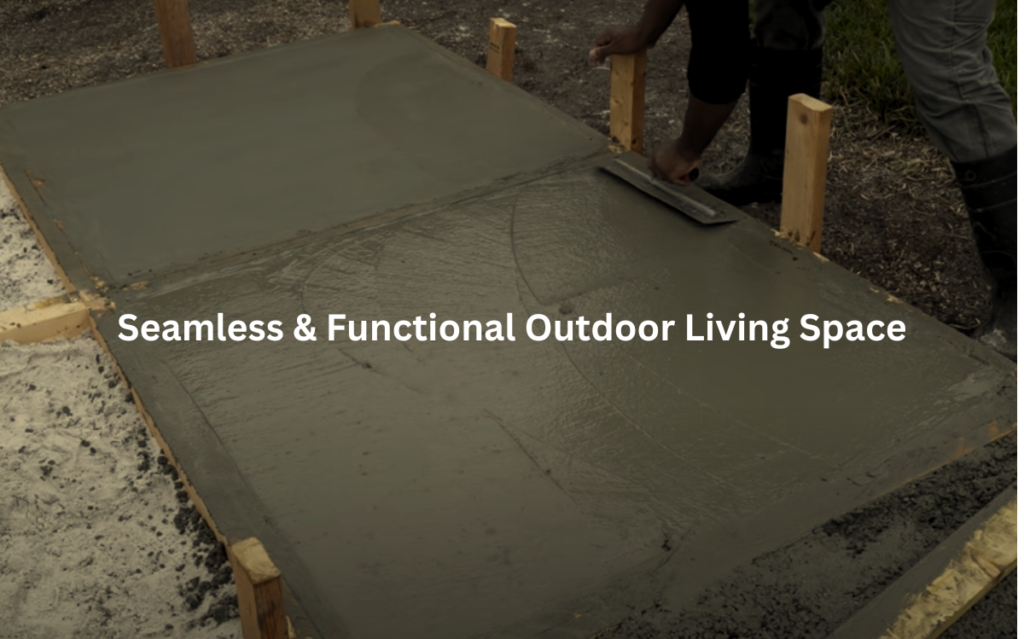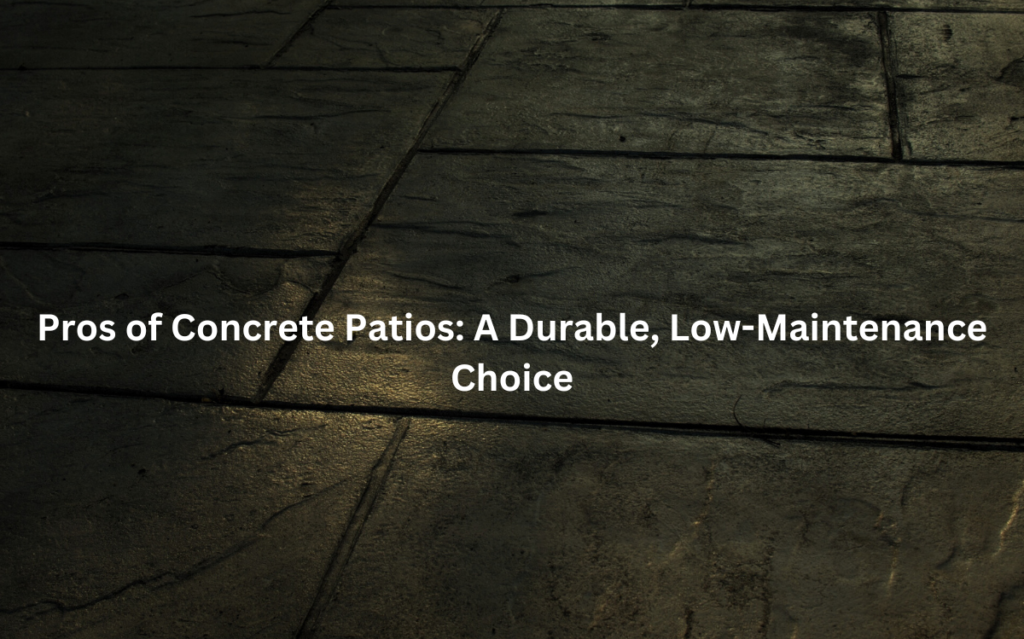Concrete patios offer durability, low maintenance, and design flexibility—perfect for homeowners seeking a stylish, hassle-free outdoor space.
Concrete patios are a durable, low-maintenance, and cost-effective option for outdoor spaces. Unlike wood decks or paver patios, they resist harsh weather, heavy foot traffic, and pests. With minimal upkeep, they don’t require sealing, staining, or frequent repairs.
Stamped, stained, or textured finishes allow for custom designs that mimic natural stone or brick. Their seamless surface prevents weed growth and shifting, unlike pavers.
Concrete’s affordable installation and long lifespan make it a smart investment for homeowners seeking a functional, stylish outdoor area without constant upkeep. Ideal for entertaining, dining, or relaxing, a concrete patio enhances any backyard. (1)
Key Takeaways
- Long-Lasting & Weather-Resistant – Withstands extreme weather, moisture, and heavy use without rotting or warping.
- Low Maintenance & Cost-Effective – Requires minimal upkeep and offers a high return on investment.
- Customizable & Stylish – Comes in numerous designs, colors, and textures to match any landscape or home style.
Durability & Weather Resistance
Concrete is tough. It doesn’t warp like wood decking or shift like paver patios. A well-poured concrete slab can last decades, handling everything from harsh weather conditions to heavy foot traffic. Unlike natural materials, it doesn’t crack easily under pressure—unless there’s poor installation or structural movement underneath.
Weather? No problem. Concrete stands up to extreme temperatures, whether it’s scorching summers or freezing winters. Unlike wood, it won’t expand and contract with the seasons, reducing the risk of warping or splitting. And moisture? While some materials rot or grow mold, concrete simply sheds water, especially when properly sealed.
Chemical resistance is another plus. Some patio materials get stained by spilled drinks, oil, or harsh chemicals—concrete, when sealed, shrugs it off. A quick rinse or scrub keeps the patio surface looking fresh.
Low Maintenance & Longevity
Homeowners who don’t want to spend weekends on frequent repairs love concrete patios. Unlike wooden decks, which require staining, sealing, and replacing warped boards, concrete needs regular cleaning and an occasional reseal.
No need for pest control, either. Termites, ants, and rot eat away at wood decking, while paver patios often suffer from weed growth between joints. Concrete avoids these headaches.
Sealing helps. Applying a sealant every few years prevents water absorption, stains, and surface damage. Some sealants even come in various colors, adding another layer of personal style to the patio design.
Cost-Effectiveness & High ROI
Budget-conscious homeowners often choose concrete patios over natural stone patios or wood decks. The initial installation cost for concrete falls between $2–$8 per square foot, compared to $15–$20 for natural stone or even more for composite decking.
Long-term savings add up. With minimal maintenance requirements, concrete doesn’t need the annual upkeep that wood requires. No need for replacing rotted boards or resetting loose pavers. This makes concrete one of the most cost-effective solutions for a functional patio.
And when it’s time to sell? A well-maintained concrete patio boosts curb appeal. Potential buyers see it as a low-maintenance upgrade, increasing the return on investment for home improvement projects.
Design Flexibility & Customization
Forget the dull gray slabs of the past. Modern concrete patios come in a wide range of design options. Stamped concrete can mimic natural stone, brick, or even wood grain, while colored concrete lets homeowners match their patio materials to their home’s aesthetic appeal.
Patterns? Plenty. Geometric designs, brick patterns, and intricate textures create a high-end look at a fraction of the price. Homeowners can even mix solid colors or apply chemical stains for a unique finish.
The result? A patio that blends with any landscape design—whether it’s a rustic backyard oasis or an already-modern place.
Seamless & Functional Outdoor Living Space

Concrete patios expand a home’s outdoor living space. They’re functional, durable, and perfect for outdoor furniture, fire pits, and dining areas. Unlike paver patios, which have gaps between stones, a concrete slab provides a smooth surface—great for foot traffic and outdoor entertaining.
For homeowners who want a low-maintenance outdoor oasis, concrete is a choice among homeowners looking for a durable, stylish option. It’s also a great choice for busy homeowners—no need for frequent upkeep or structural filler for shifting stones. (2)
A well-designed concrete patio seamlessly blends into an existing architectural style, making it feel like a natural extension of the home.
Resistance to Pests & Structural Issues
Termites don’t eat concrete. That alone makes it a better option than wood decking. Concrete patios also avoid problems like rotting, splintering, or warping, which plague wood over time.
Cracks can happen, though. But proper installation—reinforcing the concrete and controlling moisture levels—reduces cracking risks. For existing cracks, structural fillers and sealants can restore the surface without needing a complete replacement.
The result? A long-lasting, damage-resistant surface that handles heavy use, extreme weather, and shifting soil better than many other patio options.
Comparison with Other Patio Materials
Choosing a patio material isn’t just about looks. Here’s how concrete compares:
- Concrete vs. Wood Decking – Concrete lasts longer, requires less maintenance, and resists weather damage better than wood decks. No splinters, termites, or staining required.
- Concrete vs. Paver Patios – Paver patios offer more flexibility, but they require regular cleaning and frequent leveling due to shifting stones. Concrete provides a seamless surface with fewer maintenance issues.
- Concrete vs. Natural Stone – Natural stone is a premium option, but it’s expensive and requires special maintenance. Concrete can mimic stone’s aesthetic appeal for a fraction of the price.
For homeowners seeking a balance of durability, affordability, and design flexibility, concrete is often the optimal choice.
Professional Installation & Maintenance Tips
Getting a concrete patio installed correctly makes all the difference. Working with concrete patio contractors ensures proper installation, reducing cracking risks and structural issues. A professional contractor will:
- Prepare the ground properly to prevent shifting.
- Reinforce the concrete slab for added strength.
- Apply sealant colors to enhance longevity.
Once installed, maintenance is simple. Here’s a basic concrete maintenance guide:
- Daily maintenance – Sweep off debris to prevent stains.
- Regular cleaning – Wash with mild soap and water; avoid harsh chemicals that erode the surface.
- Annual maintenance – Consider resealing every 2–3 years for extra protection.
- Repairs for cracks – Use a structural filler to fix small cracks before they expand.
For deeper cleaning, a pressure washer works well—just avoid overly aggressive settings that can weaken the surface.
Final Thoughts
Concrete patios offer a low-maintenance, long-lasting solution for homeowners who want a functional, stylish outdoor space. They’re durable, handle extreme weather, and come in thousands of options for custom designs.
Compared to wood decks, paver patios, and natural stone, concrete provides the best balance of affordability, strength, and aesthetic appeal. And with proper installation and upkeep, a concrete patio can remain a beautiful outdoor feature for decades.
For those considering a backyard renovation project, concrete remains a viable option—one that’s cost-effective, versatile, and built to last.
Contact Lapis Patios today for expert craftsmanship and a stunning outdoor upgrade.
FAQ
How does the durability of concrete patios compare to wood decks and paver patios?
Concrete patios are far more durable than wood decks and paver patios, especially when exposed to harsh weather conditions and heavy foot traffic.
Unlike wood, which can warp, rot, or attract termites, concrete stays intact without issues like cracking or pest damage. It can withstand extreme temperatures, moisture, and chemical stains, making it a reliable choice for outdoor spaces.
While pavers can shift and require re-leveling, concrete’s solid surface remains stable for years. This longevity means fewer repairs and replacements, ultimately saving homeowners time and money.
What are the maintenance needs for concrete patios compared to other patio materials?
One of the biggest benefits of concrete patios is their low maintenance requirements. Unlike wood decking, which needs regular sealing, staining, and even pest control, concrete patios only require occasional cleaning to keep them looking great. Depending on the climate, resealing the surface every few years is typically all that’s necessary.
Paver patios, though similar in maintenance, can suffer from shifting stones that need repositioning, and their joints often require regular refilling. Concrete, especially when treated with sealants, is much less prone to weeds and cracks, making it a hassle-free patio material for homeowners with busy lifestyles.
Can concrete patios be customized to match my home’s aesthetic?
Absolutely. Concrete patios offer a high degree of customization, allowing homeowners to express their personal style through various design techniques. Concrete can be stamped, stained, or textured to mimic high-end materials like natural stone, brick, or wood—without the hefty price tag. You can also choose from an array of colors and patterns to complement your home’s architecture.
Geometric and intricate designs are popular options for those looking to add curb appeal. Whether you want a sleek, modern look or a rustic, natural feel, concrete can adapt to fit any aesthetic, providing both functionality and beauty in your outdoor space.
Are concrete patios eco-friendly compared to other materials like natural stone or wood?
Concrete patios can be a more sustainable option when compared to materials like natural stone or wood. Concrete is made from abundant natural resources and can last decades, reducing the need for frequent replacements. This durability means less waste over time. Additionally, many concrete manufacturers now offer eco-friendly products, including concrete made with recycled materials.
When properly maintained, concrete also requires fewer repairs and replacements, further minimizing its environmental impact. While natural stone may seem like a green choice, it requires energy-intensive quarrying, and wood, depending on its source, can contribute to deforestation if not sustainably sourced.
What are the potential disadvantages of choosing concrete patios over other materials?
While concrete patios offer many benefits, they aren’t without drawbacks. One potential disadvantage is that, despite its durability, concrete can crack over time due to shifting soil, freeze-thaw cycles, or heavy impacts.
Though these cracks can be repaired, it’s something to keep in mind if you’re looking for a completely seamless surface. Additionally, concrete can be prone to staining if not properly sealed, especially when exposed to harsh chemicals or oils.
Finally, while concrete is more affordable than natural stone or wood decking, the initial installation cost may be higher than some paver patio options. For homeowners on a tight budget, this could be a factor to consider.
References
- https://pattersonscapes.com/news/4-benefits-of-concrete-patios/
- https://landdesignsbycolton.com/pros-and-cons-of-a-concrete-patio/

